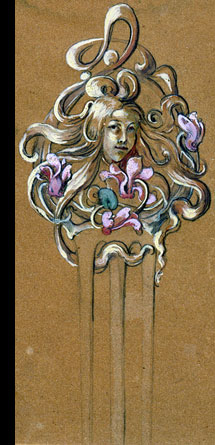|
Upon arriving in Paris on September 16, 1899, Goetz' friend Buhse introduced him to Monsieur E. Philippe, the man Buhse worked for as a chaser. Philippe's business was in articles made of silver. In 1899, Philippe offered Goetz a place in his company as the man in charge of design and production. Goetz accepted and convinced Philippe that they had to work on a backlog of orders with a view to the future. With the prospect of this proposal, he drafted a large number of designs for the articles they wanted to sell. The items were stamped in relief and sold to wholesale silverware dealers. Very much in demand were cigarette cases, ashtrays, decorative plates, toilet articles, and umbrella and walking stick handles. Philippe's role in this enterprise was that of the financier.
It was Goetz's idea to send Philippe on a sales trip to Switzerland. "The success was amazing," Goetz said. They moved to larger quarters, a studio with three large, airy rooms. One room became Goetz's office, workshop, and also living quarters. Orders came in faster than the pieces could be made.
The financial strength of Monsieur Philippe turned out to be weak and the company ran into cash flow problems. The weekly pay to the staff became smaller and smaller; there were harsh arguments and Goetz decided that the time had come to part company with Philippe. An additional reason contributing to the break-up was Philippe's insistence that Karl Goetz apply for his French citizenship. "It would be good for business," he said. "For heaven's sake, and what for?" Goetz replied. Goetz quit on March 20, 1900 to become independant. As noted here in his arbeitsbuch entries, Goetz entered his own record of work for the very first time. And why not, he had more than ample time under his belt to fulfil his journeyman requirements as graveur. The time was ripe to set out on his own path.
|
 |